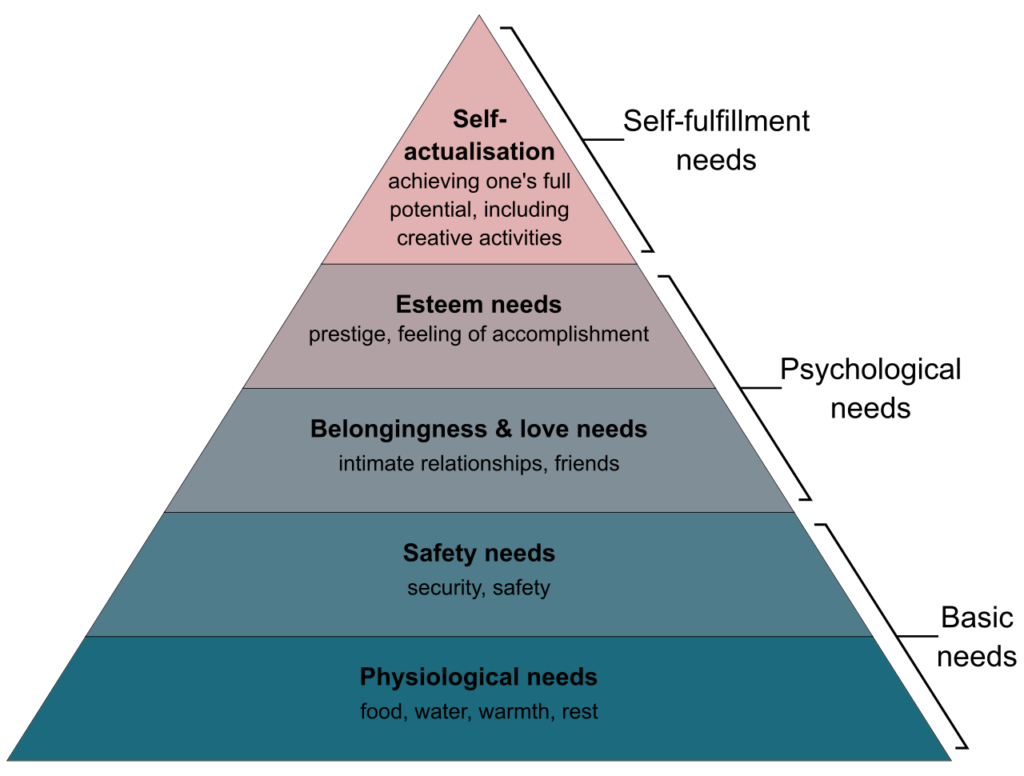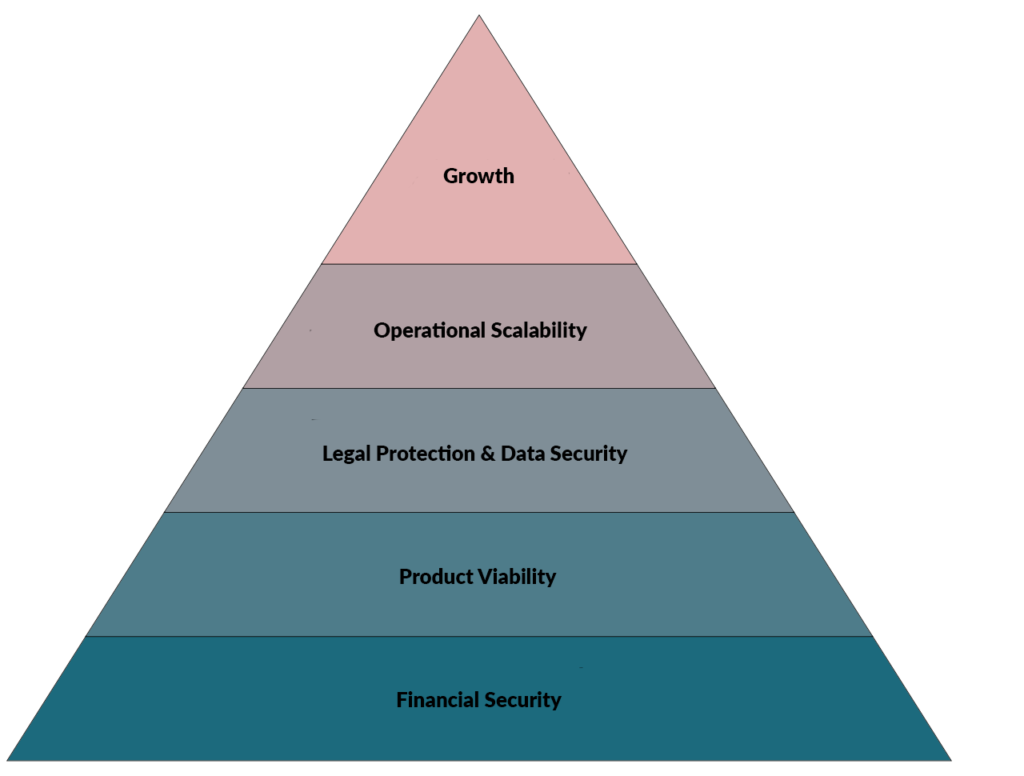Maslow’s Hierarchy of (Business) Needs – A Bootstrapper’s Guide
Prioritization is one of the most important skills a bootstrapper needs. It’s a skill you likely use all the time day-to-day. But it also has an important role in helping you achieve your longer term goals.
When I write about prioritization, I mean addressing the core needs of your business in a smart and structured way.
Psychologist Abraham Maslow came up with the notion that a person’s needs can be described as a pyramid. It’s a famous model that you’ve probably seen plenty of times, so I won’t go over well-trodden ground. But the most important take-away from Maslow’s hierarchy is that in order to move up the pyramid, you need to have satisfied the layers below. You can’t reach a feeling of safety while you’re at risk of running out of food. You likely wouldn’t feel much accomplishment if you didn’t have close connections with friends and family to share it with. And so on.

From a practical perspective then, Maslow’s hierarchy can be seen as a prioritization process. You must first meet the needs of layer 1 before you can move to up layer 2. That is the kind of prioritization I want to talk about when it comes to managing a bootstrapped startup.
What would a needs-hierarchy look like if it were addressing a business instead of a human-being?
I am 99% certain hundreds of business studies students will have done this exercise before. But as a bootstrapper who has gone through this process in its entirety, I feel like I have a real-world perspective I can add. This is how I perceive our hierarchy of business needs:

Priority 1: Financial Security
This is obvious. You need to be able to eat and pay the bills. You need money. Starting a new bootstrapped venture is a precarious balancing act. In fact it can sometimes seem like vicious circle. You need to invest your time and money into building your team, products and marketing, but you need your team, products and marketing to be able to make money. Actually, you don’t.
You will need to spend time making money. That is undeniable. But the business model you use to make money in the short-term doesn’t need to be the same as your long-term business idea.
Products need time and resources up-front before they yield any income. And unless you can somehow convince a would-be customer to buy into your idea before it’s even been built – which is possible but pretty difficult – then you’re going to need a reliable separate income stream.
Services, unlike products, don’t need much upfront investment. If you have a valuable skill – which you presumably do if you’re starting a new company – then you can sell the skill directly to others. That is how we started our business. As a quasi services, quasi product company. In fact, in the end the services side of our company developed so much that it ended up breaking away and becoming its own company. But that’s another story.
But here’s an important point, which I will codename #relevant: Whatever your alternative source of income is, it should ideally be directly related to your product. It shouldn’t just be that you drive an Uber or work in a supermarket for some extra dough. Although if things get desperate then, you can make an educated choice.
Eventually though, if you keep going at this, you will have created your MVP and it will start bringing in some money. Hopefully enough money in time to phase out your services side-hustle entirely and begin to focus 100% on the product itself.
Priority 2: Product Viability
Once your business is financially stable, you can start to really focus your time and effort into the product. There is a risk here though. While to reach this point, you know that your product obviously has *some* value. Else it wouldn’t have helped you reach financial stability. You don’t necessarily know that it has *lots of* value yet.
You may have just spent quite a lot of time and effort struggling to reach this point only to discover that your product just doesn’t have that much potential.
This particular conundrum is why a lot of people – particularly in the funded-startup world – would say that product viability should come before financial stability. “Fail fast” is a particularly popular phase. And it makes sense. But failing fast when you’re failing with other people’s money (OPM) is a different story to failing with your own savings and main source of income.
So aside from being fortunate, how do you prevent or mitigate this particular risk? This is where #relevant comes in. If your side-hustle from Priority 1 has direct relevance to your MVP, then it gives you an extra edge when it comes to getting a deeper understanding of the industry, the customer, and of the challenges your MVP will help to solve. It will help you hone your skills and keep you at the bleeding edge.
Whereas if you’re supplementing your income by driving an Uber, you’re going to be missing out on this invaluable experience.
The rest comes down to iteration. Build-Measure-Learn-Build-Measure-Learn, ad infinitum. This is really the only sure-fire way of making sure your product is in-line with the market and providing a great solution to a genuine requirement. The details are unimportant. Avoid assumptions, just trust in the scientific style methodology of continuous improvement, and you will end up with a viable product with a great product-market fit.
Priority 3: Legal Protection and Data Security
Ok, you’ve done it. You have a stable business and you know that your product is viable. You’ve come a long way. Suffered a lot of pain and stress. Now you’ve really got something, you’ve got something to lose.
Up to this point you’ve probably been a tiny bit casual with how you’ve done certain things. You’ve been using a cheap templated contract that you bought online. You went for the cheapest tier of business insurance. You’ve adopted and invested in *some* security measures, but there are still a few gaps.
Now is the time to seal the whole thing up. Start putting in place the armor to protect your business and make sure that even if something does go horribly wrong, it’s not going to be game over.
- Get a lawyer to review your customer contracts, employment contracts and other legal agreements
- Speak to your insurance broker about improved cover
- Talk to your accountants and solicitors about your company structure to make sure your product’s IP is protected
- Hire a security consultant to do an audit – even consider going through a formal process like ISO27001.
- Start to formally and regularly evaluate and manage your risks
Priority 4: Operational Scalability
For me, this is where things start getting a lot more fun. Get out your magnifying glass, and start looking at your business like you’ve never done before. This is going to take time, so be patient. Just take everything you’re doing, one piece at a time and ask yourself whether it makes sense. Can it be done better. Can it be done quicker? Can it be automated? Or best yet, can you get rid of it entirely and just simplify your process?
Scalability has to be built on strong but simple foundations. You cannot scale complexity. It will turn into a nightmare. So you need to think about what really matters. You need to be ruthless. And you need to be smart. Leave no rock unturned. Work your way through the entirety of your business looking for better ways of doing everything.
- Look at whether you can integrate different systems together to help automate processes and remove duplication. E.g. can you integrate your CRM with your contracting tool? How about your CRM with your accounting package?
- Can you help your customers do more themselves? And ensure that they have as much autonomy as possible, including self-serving support if they need help fix an issue?
- Can you help automate your sales process?
- How about your marketing?
- Are there any sticking points for your team? Anything they find particularly onerous.
- Is your website converting as well as you’d hope? Perhaps you should review your SEO/CRO.
There is so much to do here that I could, and probably will, write multiple posts about it all in future. But the key is to just be systematic. Focus on the important interactions first, particularly the period of time between a prospect first discovering you to them placing an order for your product. After you’re satisfied with this process, then just keep going until you’ve turned your entire business into a beautiful well-oiled machine.
Priority 5: Growth
I’m not a growth hacker. And I don’t necessarily think that growth in the traditional sense (e.g. financial) is the zenith of a business. And no I’m not a communist. But business is more important than profit. What I mean by growth is advancement, evolution, learning, adaptation, the solving of problems, the attainment of goals, and the realisation of dreams. Money is just a bonus part of the package.
If you work your way through the other priorities, this is where you will end up. And what you do from here is really up to you. That is the point of getting here. To reach true business freedom. A type of freedom that is unique to successful bootstrapped startups. Once you’ve reached this point, all the VC-funded startups will look upon you with jealousy and awe.

